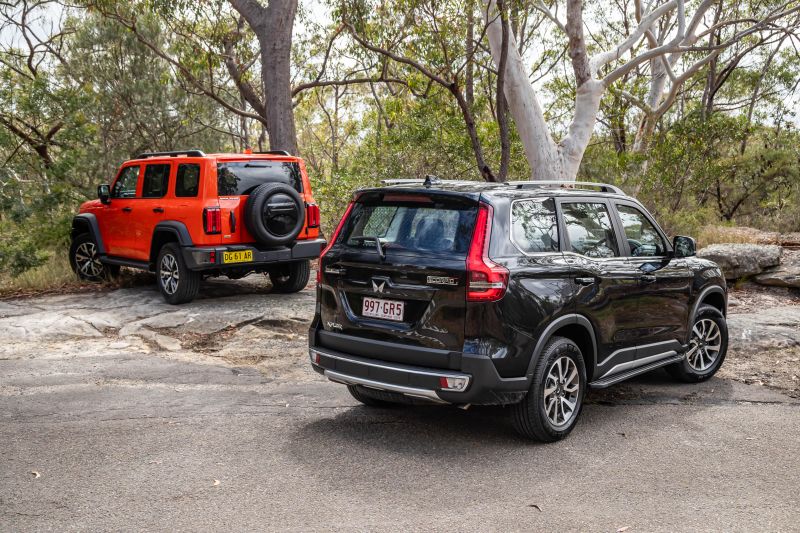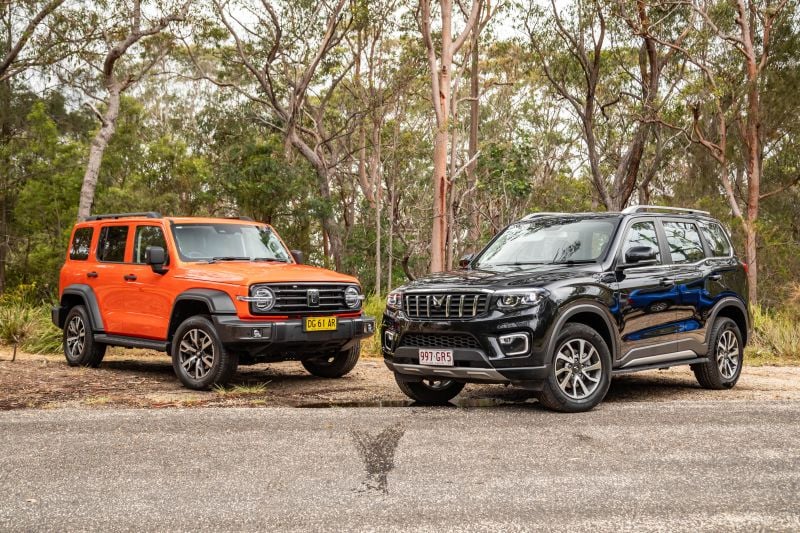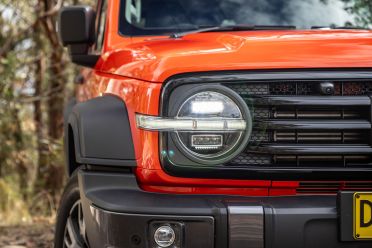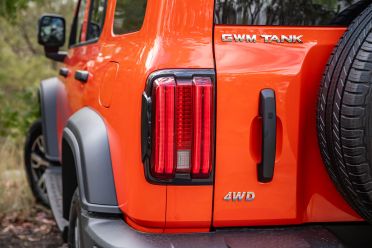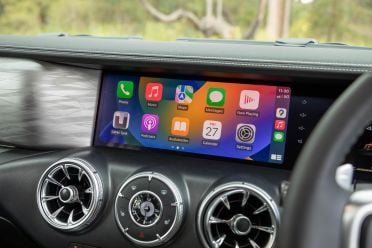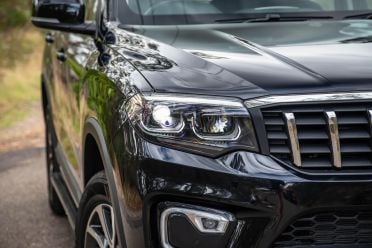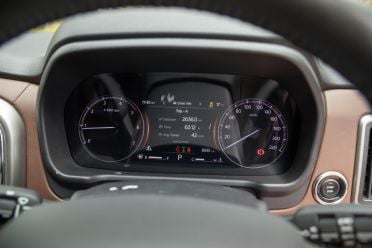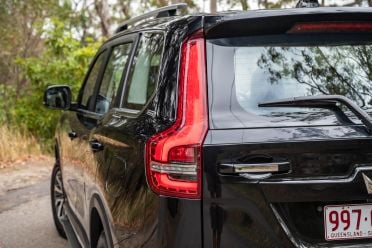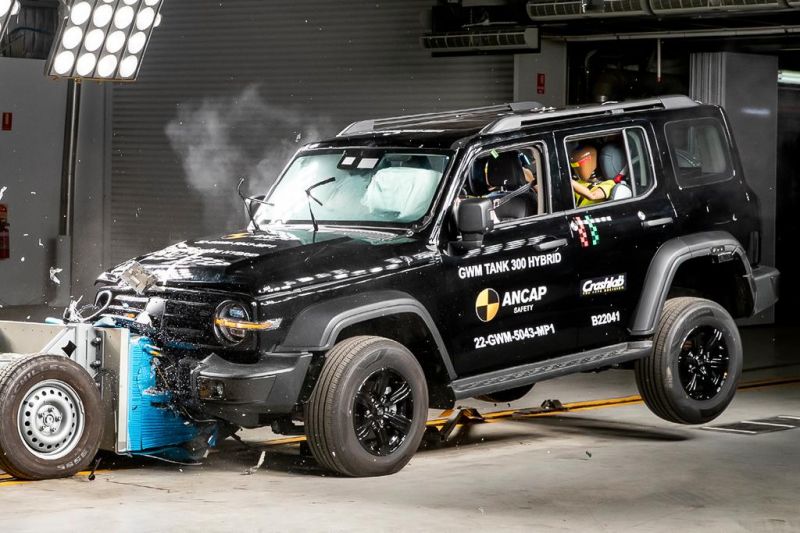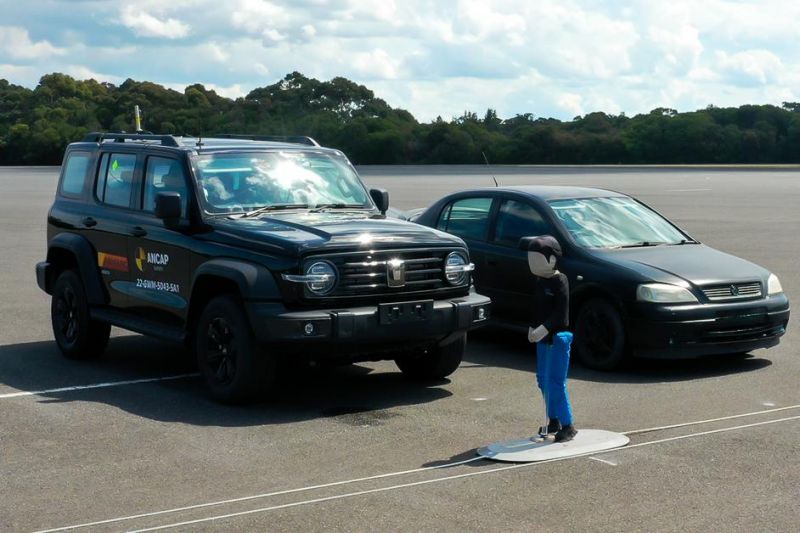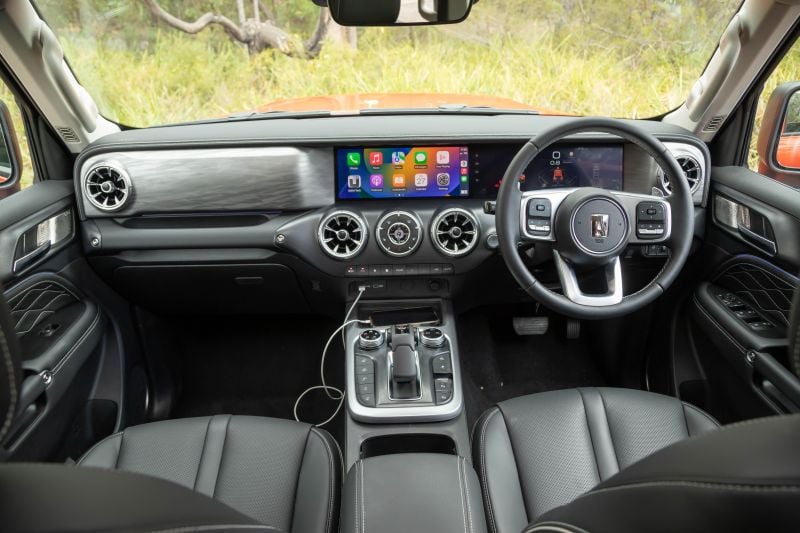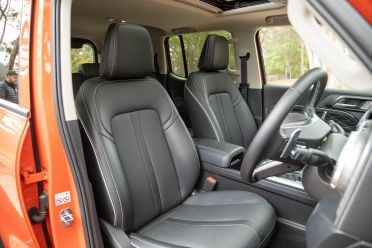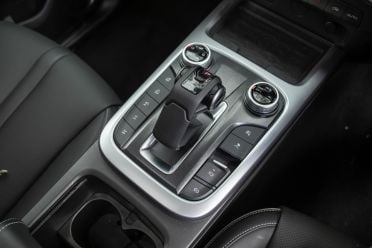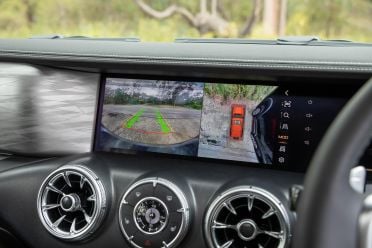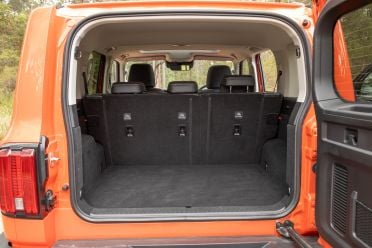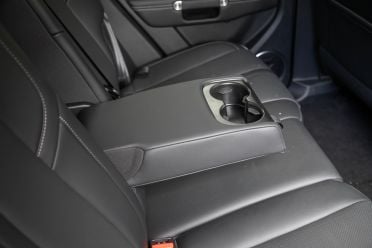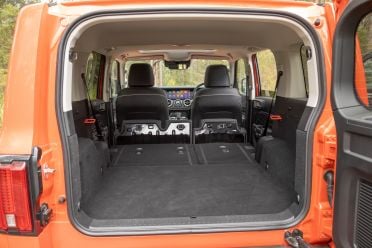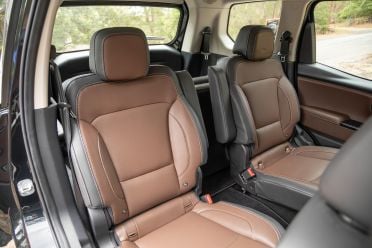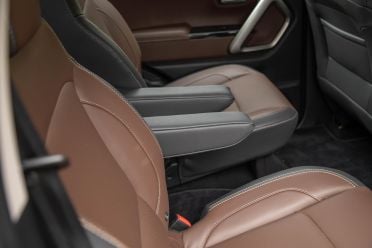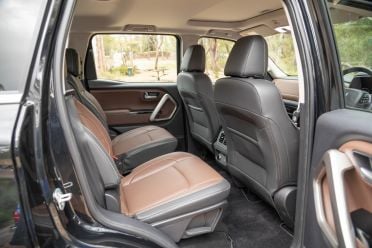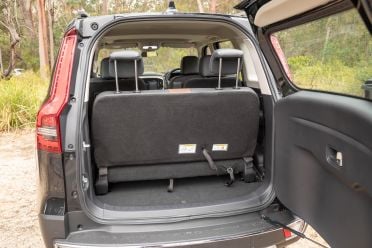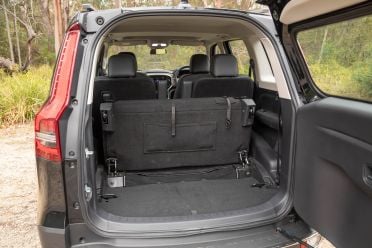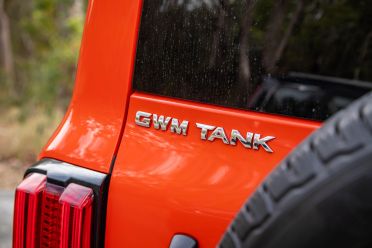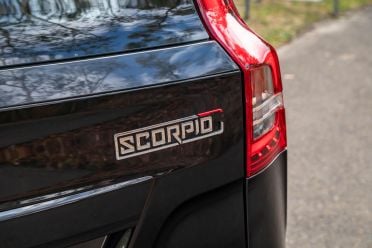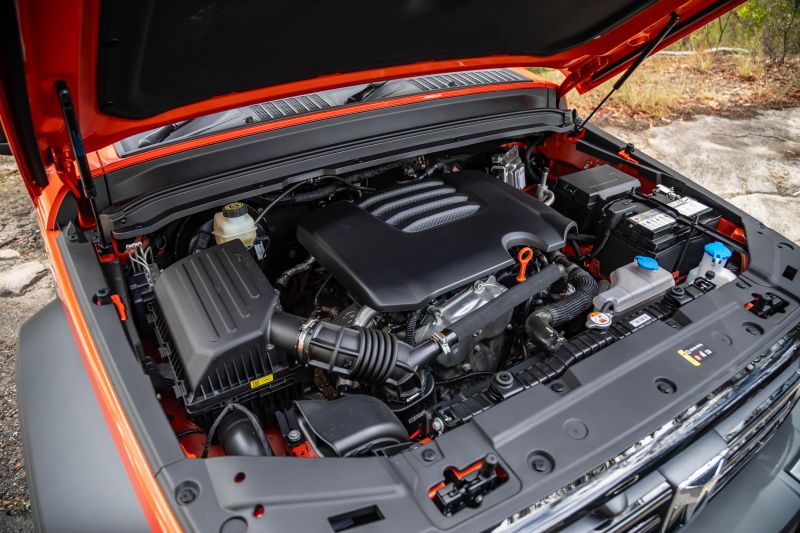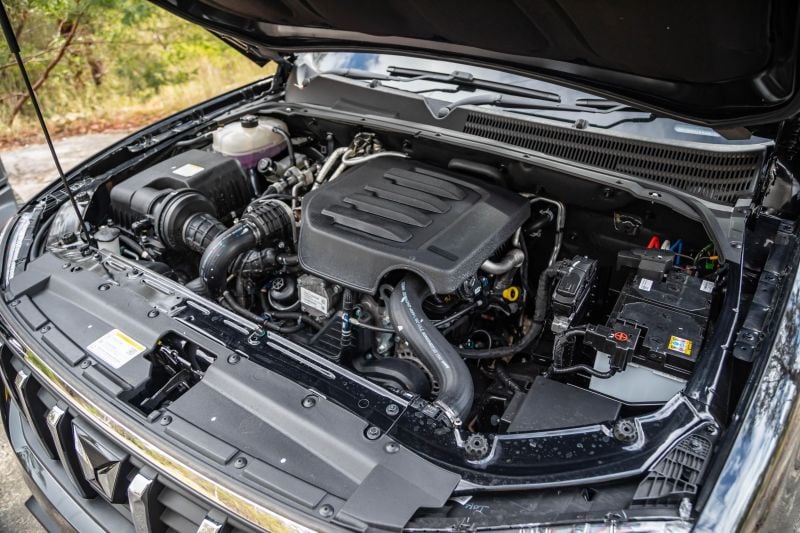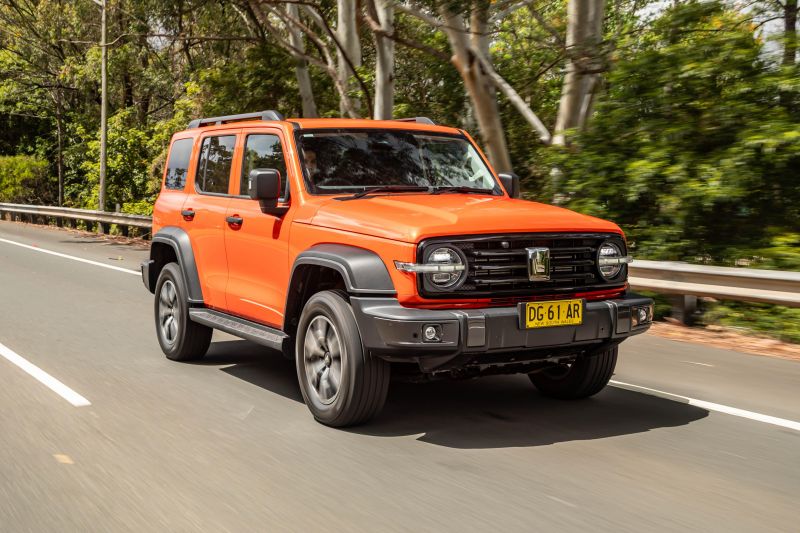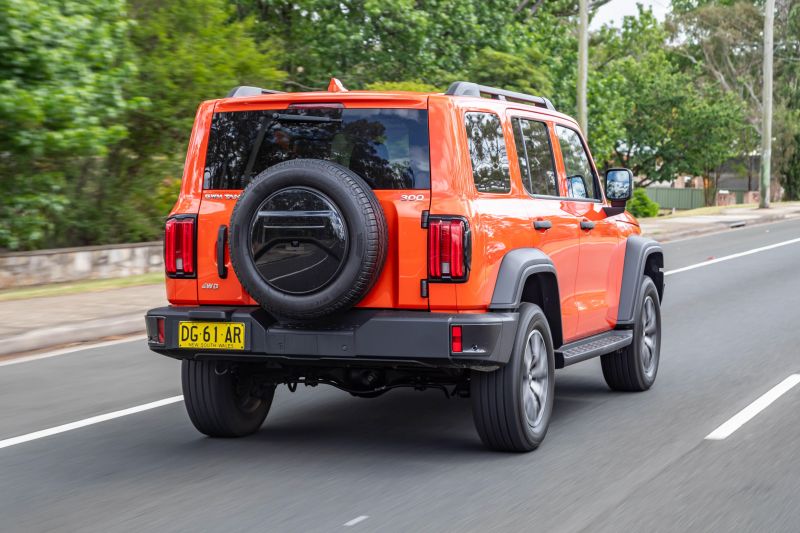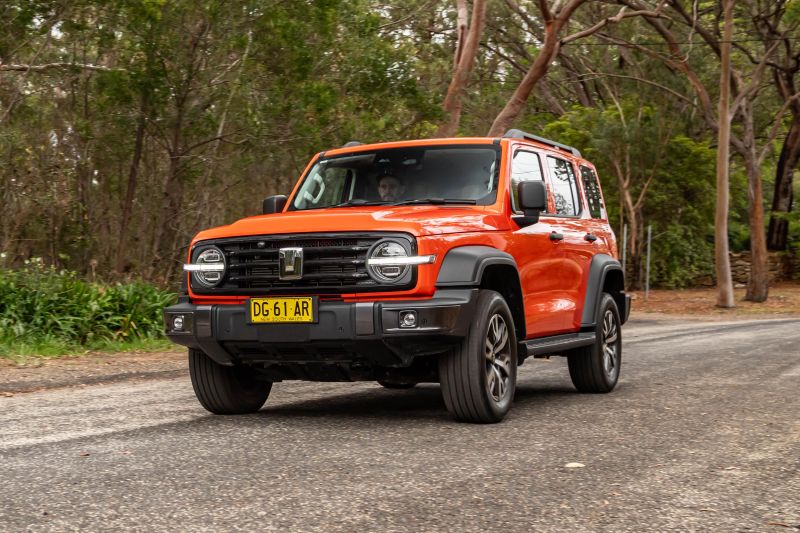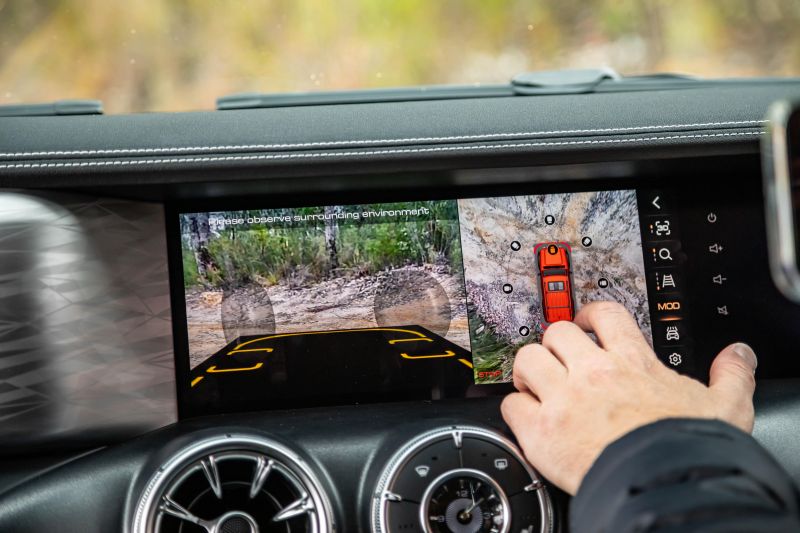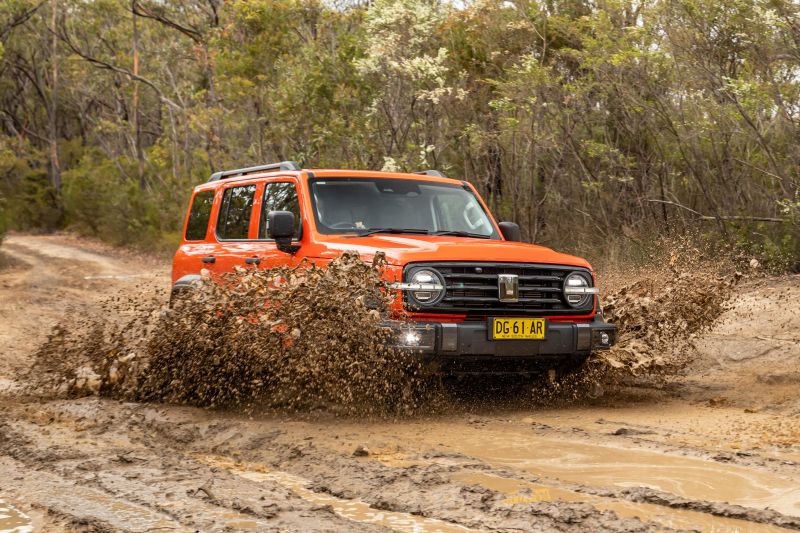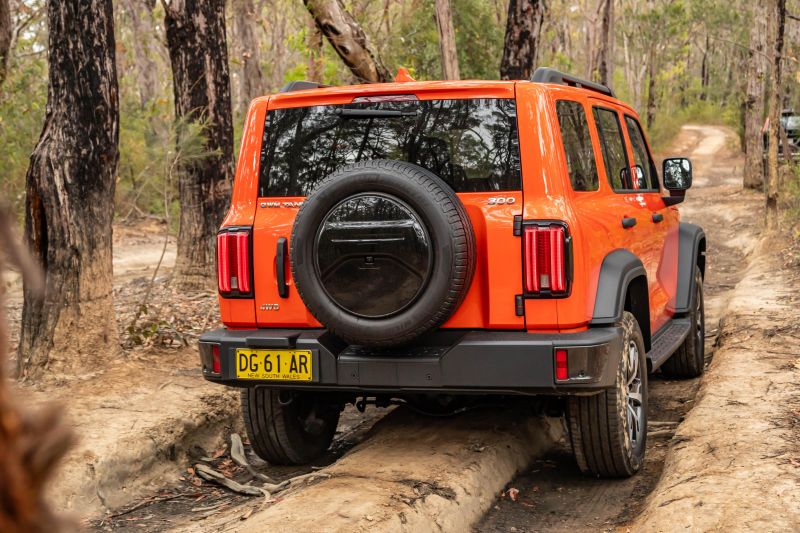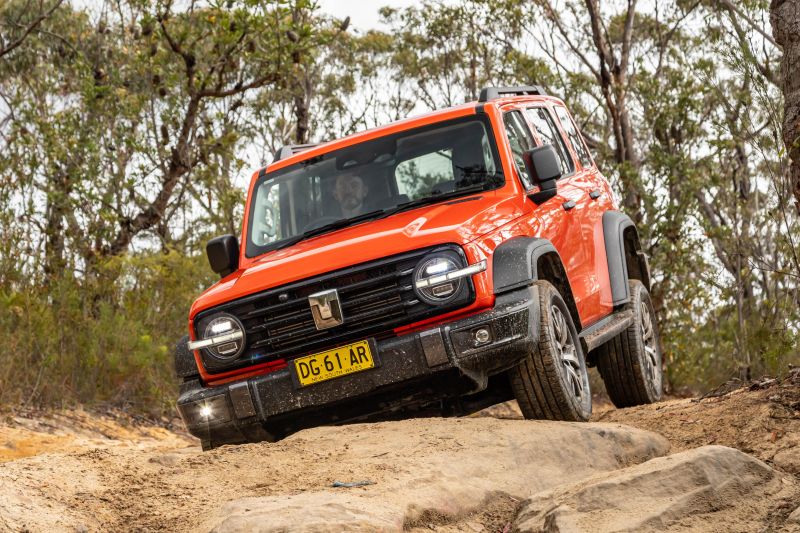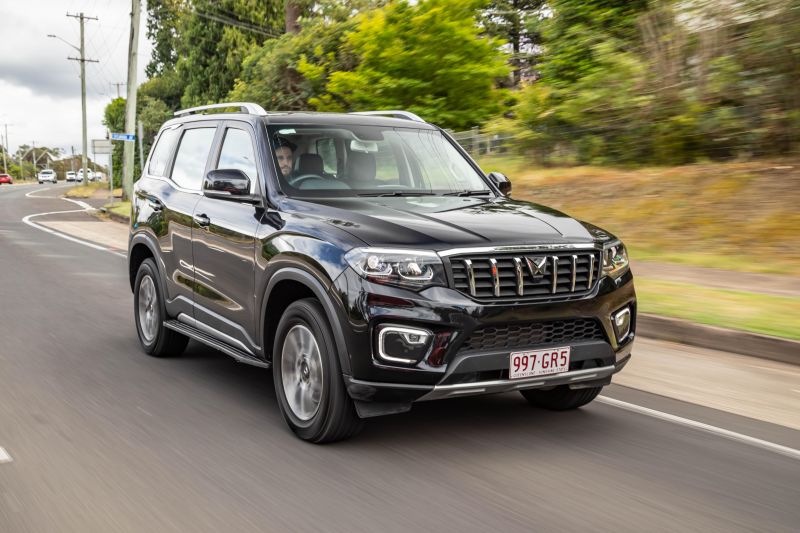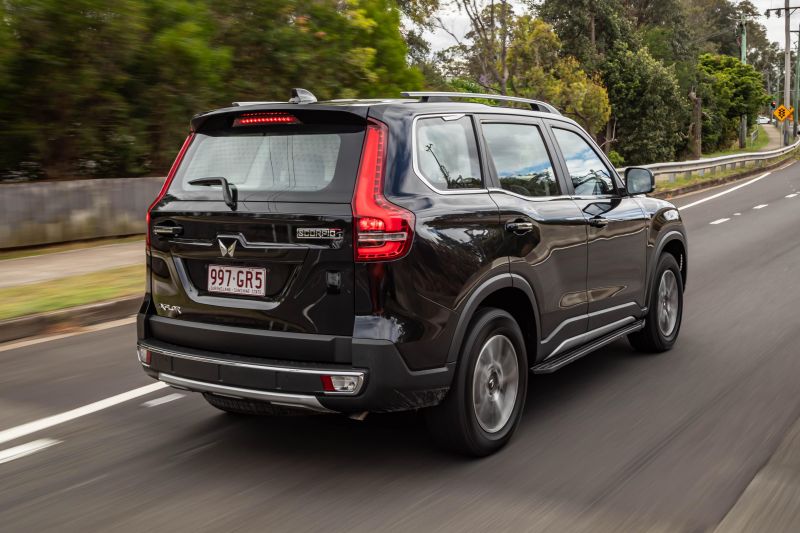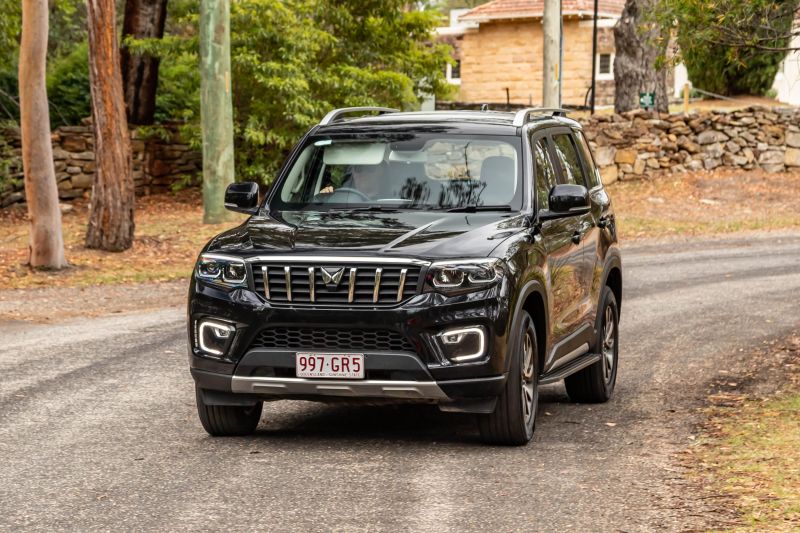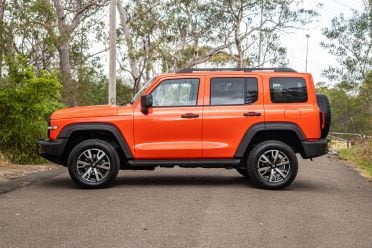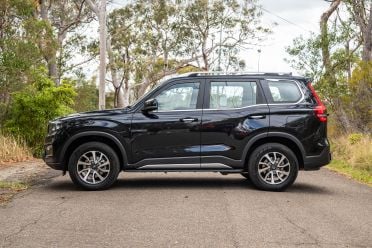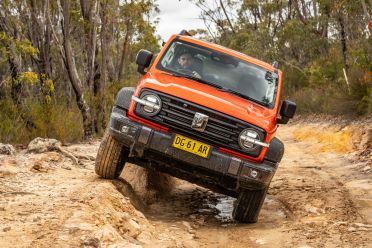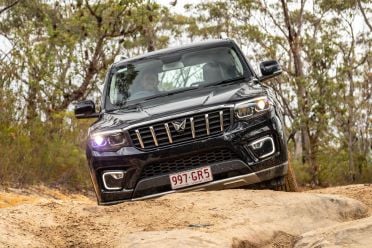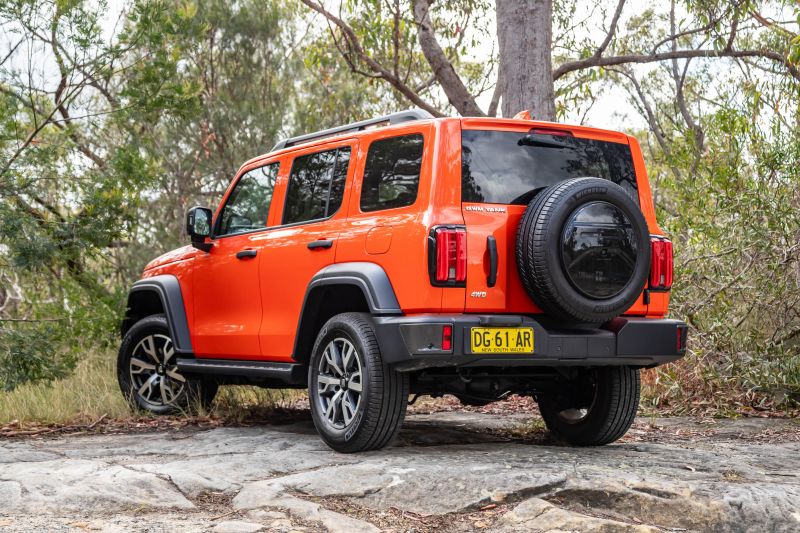There is no way anyone could have predicted a showdown between China and India that looked like this, and as closely matched as this.
That’s because the Chinese-made GWM Tank 300 and the Indian-built Mahindra Scorpio (known as Scorpio-N in its home market) are two extremely good four-wheel drive SUVs that are as at home on the school run as they are tearing up trails in the bush.
There’s not a lot between them when it comes to price, but the GWM has a fair bit more going for it when it comes to standard safety gear and technology. But with three rows of seats and a strong diesel engine, the Mahindra has plenty to offer as well.
Which is the better of these two budget-friendly models? Read on to find out.
How much?
These two models have relatively low pricing on their side. They might be mid-sized SUVs with serious off-road capabilities, but they’re priced close to what you’d pay for a well-specced medium front-wheel drive SUV.
The more affordable of the two is the Mahindra Scorpio, which we have in Z8L flagship spec with a national drive-away price of just $45,990. If that’s too high for you, there’s a cheaper Z8 model for $41,990 drive-away.
While the GWM Tank 300 might seem very pricey in comparison, with the Ultra petrol tested here lists for $50,990 drive-away. Likewise, there’s a cheaper Lux model for $46,990 drive-away if you want to save a few bucks.
But you won’t want to – because you get heaps of additional gear for your money, as you’ll see in the next section.
What do you get?
Here’s a rundown on each of the models and the variants available, which should help you decide what one might be right for you, money-wise.
Tank 300 Lux highlights:
- 17-inch alloy wheels
- Auto-folding, heated exterior mirrors
- LED headlights, tail lights
- Daytime running lights
- Sunroof
- Two-piece under-body guard
- Tyre pressure monitoring
- Crawl Control
- Tank Turn
- Front and rear parking sensors
- Power driver’s seat
- ‘Comfort-Tek’ leather upholstery
- Microfibre and leather steering wheel
- 12.3-inch digital instrument cluster
- 12.3-inch touchscreen infotainment system
- Front and rear USB ports
- Apple CarPlay, Android Auto
- 9-speaker audio system
- Ambient interior lighting
- DAB+ digital radio (hybrid only)
- 12V power outlets (front and luggage cabin)
Tank 300 Ultra adds:
- 18-inch alloy wheels
- Nappa leather seats
- Heated, cooled front seats
- Power driver seat with massage function
- Heated, leather-wrapped steering wheel
- Wireless phone charging
- Infinity 9-speaker sound system
- More ambient lighting colours
Tank 300 Ultra Hybrid adds:
- Semi-autonomous parking assist
- Driver’s seat and mirror memory
- Auto reverse tracking
Scorpio Z8 highlights:
- 18-inch diamond-cut alloy wheels
- Double-wishbone front suspension
- Watt’s linkage rear suspension
- Auto LED headlights (projector-type)
- LED projector fog lights
- LED tail lights
- LED sequential indicators
- Rain-sensing wipers
- Chrome door handles
- Power-folding side mirrors
- Sunroof
- Silver roof rails
- Rear spoiler
- 4.2-inch monochrome digital instrument cluster
- 8.0-inch touchscreen infotainment system
- Apple CarPlay, Android Auto
- Front USB port
- Second row USB-C port
- Dual-zone climate control
- Second row air-conditioning
- Activated carbon filter
- Cooled glove box
- Leatherette-wrapped steering wheel
- Leatherette-wrapped gear shift lever
- Keyless entry
- Push-button start
- Coffee Black leatherette upholstery
- Driver lumbar support
- Second row one-touch tumble
- Third row fold and tumble
Scorpio Z8L adds:
- 7.0-inch colour digital instrument cluster
- 12-speaker Sony sound system
- Wireless phone charger
- Front camera
- Front parking sensors
- 6-way power driver’s seat
Are they safe?
Both have five-star safety ratings, but they are not the same when it comes to safety gear.
That’s because the Mahindra has its five-star rating from the Global NCAP assessment program tested in 2022, which is more focused on crash safety than advanced technology.
When it comes to the GWM Tank 300, it achieved the maximum five-star ANCAP safety rating based on 2022 testing, which means it has a strong complement of crash avoidance technology as well as lots of airbags and a strong performance in crash testing.
The point here is really, the Mahindra is behind on the passive safety front. There will be some buyers who don’t want those intrusive technology features in their car, especially for those who do a lot of off-roading.
There is going to be an update with some advanced safety technology offered in the Scorpio, likely in the next 18 months – so if it matters to you, wait for the update, but it’ll cost more money.
Scorpio standard safety features:
- 6 airbags
- Rear parking sensors
- Reversing camera
- Tyre pressure monitoring system
Scorpio Z8L adds:
- Front parking sensors
- Front-facing camera
Tank 300 standard safety features:
- 7 airbags incl. front-centre
- Adaptive cruise control
- Autonomous emergency braking (AEB)
- Pedestrian, Cyclist detection
- Junction assist
- Blind-spot monitoring
- Lane departure warning
- Lane keep assist
- Rear cross-traffic assist
- Surround-view camera incl. ‘Transparent Chassis Function’
- Traffic sign recognition
Tank 300 Hybrid adds:
- 6 parking sensors (up from 4)
- Front cross-traffic assist
It’s no contest when it comes to safety tech. But as you’ll read in the driving section, there are some things the Tank 300 doesn’t do well when it comes to the application of said safety tech.
What are they like inside?
GWM Tank 300
These two might have launched in Australia within months of each other, but it feels like there are light years between the two when it comes to interior design.
The Tank 300 looks like a Mercedes G-Wagen inside, with some stunning finishes and treatments, lovely materials and a pair of huge high-resolution displays in front of the driver.
I am convinced this is one of the most impressive interior designs of any vehicle at this kind of money, because it has fairly decent functionality – including an array of buttons for the controls for the climate system – but also those big screens really do give the cabin some serious wow factor.
They’re not perfect, but you do get used to the controls of the screens quite quickly, and there is a way to set up favourites on a pulldown menu at the home screen – annoyingly, not the ones that you probably wish you could add there as quick buttons (like emergency lane keeping).
The ambient lighting around the cabin – in the doors, front, and rear, inside the vents, and in the dashboard – leaves a huge impression on people who’ve never sat in a car with that sort of technology. It is really quite stunning, and if you have kids, they will love it (my daughter called this the Bluey car for obvious reasons, and would joyfully exclaim the colours as they showed up on the back doors).
Just like the Mahindra, it has a wireless phone charger, but it goes further with practicality in terms of storage – there are two cupholders, a sliding tray between the seats, and a bigger centre console area.
The door pockets are also larger, and there is an additional tray down near the driver’s knee, plus a pop-out section below the right side air-vent for the driver, which isn’t a cup-holder but really should be. If you run a dash cam, there is a USB port up in the housing near the rearview mirror for quick connection and no messy cables.
Seat comfort is very good, with great adjustability, heating and cooling, as well as beautiful genuine leather trim, which just makes this feel a class above the Scorpio. There’s even a heated steering wheel which feels much nicer in your hands, too.
And there’s more back seat space in the Tank, too. With the driver’s seat set to my driving position (I’m 182 cm or 6’0” tall), I had better knee, foot and headroom in the GWM.
There’s also a flip down armrest with a pair of cupholders, and directional air vents, plus bottle holders in the doors, and just like the Mahindra, it has map pockets on the seat backs as well.
There are ISOFIX points and three top-tethers, plus you get a handy set of lights in the back to illuminate the outboard seats when you are loading a child. Just know that it is a slightly easier climb into the back seat of the Mahindra than it is in the GWM.
Mahindra Scorpio
Now, I’m not sure if you are as sensitive as I am, but the interior of the Mahindra has a distinct plasticky smell which didn’t seem to get any less noticeable over the time I had the car.
And while the interior does have decent presentation to it, it falls well behind the Tank in terms of wow factor.
I’m as big a fan of brown interior finishes as the next weirdo, and I do appreciate the fact there is not just a sea of black material in this car. And for what it’s worth, the interior feels well put together, and looks good – there is neat stitching, nice trim finishes on the seats, and soft elbow pads where they should be.
All the controls are basic and simple to get to grips with – there are buttons and dials for the main ventilation controls, and for the media system as well.
But the screen looks tiny in comparison to the Tank, and the resolution of the display is lower as well. I had no real issues with the usability of the software, and Apple CarPlay worked flawlessly via USB connection during this test. I can’t say the same for the GWM, which had intermittent issues.
One thing might be a serious concern for families, though, is that there’s only one cupholder in the front of the Mahindra, and while there are door pockets with bottle holders in all four doors, that’s about it when it comes to beverages.
The Scorpio has some cred thanks to the inclusion of third-row seats. This SUV has a 2+2+2 layout, with the middle-row scoring captain’s chairs, and the back row a stow-and-go bench seat.
What is nice to see is that the second row captain’s chairs have armrests to make things even more comfortable, although they don’t slide forwards and backwards to allow for better legroom for those riding in the middle or back row.
If you have a child seat fitted in the most conventional spot (behind the passenger), you will need to have limber back-seat riders, as they will have to squeeze through the small gap between those captain’s chairs, clamber over the top of the driver’s side one when folded because it doesn’t have the same flip-fold mechanism as the kerbside captain’s chair.
And in reality, for families with youngsters, you might find that the Tank is actually a better bet, as it has the capacity for three child seats, not just two as is the case in the Mahindra. It only has ISOFIX and top-tether points in the second row seats – there are no third-row child-seat fitment options.
Further to that, there are no vents in the very back row, only in the second row seats are there directional air vents – but there is a fan controller, along with a USB-C port.
Honestly, this car makes more sense as a 2+2 with a really big boot, if you were to remove the very back-row seat. I know that’s what I would do if I was buying it.
As for boot space, the Scorpio is easily the more accommodating choice… kind of. If you were to remove that back bench seat you’d be onto a winner, but with the third-row folded and stowed, there’s 756 litres of claimed cargo space.
The Tank 300’s boot space is far smaller at 400 litres, but it does house a subwoofer under the false floor, and a handy deployable table for camping – you actually use that floor section as a table-top, like an old Honda CR-V.
Keep in mind, though, that it’s a much higher load lip for the Tank. But it has a squarer door that means you won’t bash your head on the edge of the top (as I did in the Mahindra). Also, it has a locking strut to stop the door closing in on you when you’re parked at an angle, which the Mahindra doesn’t – though it is a pretty strong strut.
Now, this might not be something you think about often, but do you know the payload of your SUV?
It’s a consideration off-roaders might more often conjure up than mums and dads who just need to think how many bags of shopping will fit in the boot, but these two vehicles have off-road intent, so you might want to keep this in mind.
The Tank 300 has a very limited payload, with a gross vehicle mass of 2552kg and a kerb weight of 2155kg, that leaves you just 397kg to play with. That’s the available usable capacity for people and luggage.
The Mahindra has a bit more capacity to play with, thanks to a kerb weight of 2100kg and a gross vehicle mass of 2610kg, it has 510kg payload capacity.
Either way, you’re going to need to pack light. And if you’re planning on towing, you’re really going to have to consider your weights, because remember – the tow-ball down-weight needs to be calculated as part of your payload.
Both have 750kg unbraked towing capacity, or 2500kg maximum braked towing.
What’s under the bonnet?
The GWM Tank 300 is powered by petrol, and the Mahindra Scorpio runs on diesel – but both feature four-cylinder turbo engines, auto transmissions and four-wheel drive.
The Tank 300 has a 2.0-litre turbo-petrol engine with 162kW of power (5500rpm) and 380Nm of torque (1800-3600rpm). It has an eight-speed automatic transmission with paddle-shifters, with selectable four-wheel drive with high and low range (2H, 4H and 4L).
The Tank 300 also has front and rear differential locks, multiple drive modes (Normal, Mud/Sand, Rock, Mountain, Pothole), a system called Crawl Control for set-speed hill descent and ascent control, Turning Assist which locks the inside rear wheel to make it easier to get out of tight spots by effectively lessening the turning radius, and a camera system called Transparent Chassis, where you can look ‘through the bonnet’ at the road ahead.
The Scorpio has a 2.2-litre turbo-diesel producing less power, 129kW (at 3500rpm), but more torque, with 400Nm (1750-2750rpm). It’s homologated to Euro 6b standards, meaning it has a urea after-treatment (AdBlue) that requires regular topping up.
It makes use of a six-speed automatic transmission, has part-time four-wheel drive (it runs in 2WD on sealed surfaces, and you switch to 4H (high-range four-wheel drive) or 4L (low-range four-wheel drive) for unsealed driving.
There’s also a mechanical auto-locking rear differential, which works by detecting slip and locking the diff if it detects a delta between tyre speeds at the rear. Drive modes include Grass/Gravel/Snow, Mud/Rut, Sand, and Normal.
Now, let’s talk fuel. The Tank 300’s official combined cycle fuel consumption figure is 9.5 litres per 100 kilometres, which isn’t too bad considering it’s a heavy off-road-ready vehicle.
In reality, over our mix of driving and off-roading, it managed a less-than-impressive return of 13.6L/100km. It can run on 91RON regular unleaded, which is unusual for a turbo engine, and has a 75-litre fuel tank.
The Scorpio’s official combined cycle fuel consumption rating is 7.2L/100km, and this test saw a combined return of 8.9L/100km over on- and off-road cycles – impressive! It has a 57-litre fuel tank.
How do they drive?
GWM Tank 300
There’s a lot that the Tank 300 does well when it comes to on-road driving.
The standout quality here is refinement. It’s quiet, doesn’t suffer from vibration and is hardly ever harsh in the way it handles itself.
It’s arguably more refined than some 4×4 SUVs at twice its price, so if you’re after a car that’s very liveable around town, but also capable of dirty weekends away, this could be a great choice.
The engine is a highlight for the liveability factor, with the turbo-petrol showing that not all 4x4s need diesel to be good at what they do. There’s ample grunt here, and it’s perky in its response.
The eight-speed automatic also shifts smoothly and smartly, and during my time with the Tank I never found myself frustrated by the powertrain. It also has a start-stop system to try and help save fuel, but it wasn’t very active.
The steering is a bit light-on when it comes to feel, and it does require a bit more twirling of the wheel to change directions, which can feel like it’s exacerbating the softly sprung suspension and make you feel like there’s quite a bit of body roll.
Of course, it’s a tall, boxy SUV with 4WD underpinnings, so it cannot possibly be devoid of some of those attributes, but it certainly doesn’t have as tied-down a feel to it as the Mahindra does on the sealed stuff.
There are few more things that could be better about the on-road drive in the Tank 300, too.
The most notable issue is the emergency lane-keeping system. It’s edgy and interruptive when in operation, and if you don’t want it on, you have to disable it every single time you drive the car. We’ve reported GWM has an update for the system operation in the works, so hopefully it makes for an improvement.
There’s also the Tank’s braking system. It has a very spongy feel to it under hard braking, with the nose feeling like it’s stoving down into the road ahead. Some tests have even found the rear tyres can leave the surface under hard brake application, which isn’t very reassuring.
Also, the blinkers are rubbish. They are so hard to get right – they have auto cancelling, but maybe it’s my man hands, but I can’t get them to operate as they’re supposedly intended to.
Off-road
The Tank 300 is going to appeal more to off-roaders who love the technical stuff. This has buttons and modes and switches that you can engage to make this rig basically walk up and down cliffs.
However, it is annoying that you need to engage low-range to access the off-road driving modes. Sometimes you just want to keep pace with a convoy and choose a mode that will suit the situation, and typically you’d want to do that in 4H. But in the Tank, you need to choose 4L to access the modes.
That said, those modes really do make a noticeable difference to your progress and sure-footedness, and it’s a seriously mechanically capable machine – but definitely one in which you might find yourself thinking more about the modes and diff-locks and other trick systems than you do in the Mahindra.
The soft suspension setup means you also don’t have quite the same level of connectedness to the surface below that you get in the Scorpio, with a more remote feel to the experience, which is both good and bad.
It’s good because you won’t be worn out after a couple of hours of off-road tracks and trails, but bad because you might not get as much feel for what’s happening under the vehicle.
The steering, being electric rather than hydraulic, is inherently less connected to the ground, as the physical work you do at the tiller doesn’t reflect what happens at the front axle. But you still have good response and attitude at the helm, and the off-road camera system with the see-through bonnet function really does help if you’re unsure of where you’re heading.
Indeed, that camera system – which seems to have about 50 or more different views available – is a really quality bit of kit. You can see above, around, behind, in front, through, and in 2D or 3D, with guidance lines or without, and there’s even a really neat distance measuring system that can help you see how many centimetres you are from an object.
Through mud bogs the Tank felt sure on its feet, though the easiest upgrade on the planet for this vehicle would be a set of more aggressive tyres, despite the fact the Michelin rubber is a great fit for on- and off-road stuff.
We tested out the ground clearance over some rutted routes on chicken tracks around deeper bog holes, and the Tank did touch down in the middle more often than the Scorpio.
But it has the advantage of having far better off-road angles for approach and departure, thanks to its boxier body design.
And while the off-road hardware on offer might be more appealing to the hardcore enthusiast than the novice campground hunter, I can assure you that the electronic rear locking differential does its job effectively in slip-prone situations.
You will notice, however, being petrol-powered it does tend to have a bit more of a hard-revving nature in high-range, but low-range does a great job of allowing you to idle up and down hills without needing to worry about over-revving.
The Tank Turn function which locks the rear inside wheel to help you pivot on a tighter axis on one-way tracks, is a great bit of kit. It may have been user error, but I had to keep engaging the Crawl Control off-road system each time I went from drive to reverse – and I had to put the vehicle in neutral to engage it, too.
Seriously, it might have been quicker to just do a 13-point turn and get out of the situation rather than muck around for minutes to get the technology to work so I could instead do a three-point manoeuvre.
This is a serious bit of kit for those who want that sort of thing, and while it has some hardcore hardware, it doesn’t feel old-school. This is a high-tech, highly capable off-roader.
Mahindra Scorpio
This is way better than any Mahindra that has come before it, and in fact is a pretty likeable and liveable choice for families after a fun but functional fourby.
Now, while it’s not unrefined, it does feel a bit behind the times in terms of refinement levels compared to the Tank.
The diesel engine exhibits quite a bit of grumble and can be rattly and lumpy on restart, and the engine’s start-stop system is clumsy.
Our test vehicle was also showing an oil light and a battery light on the dash when the start-stop system was operating. Oddly, it would also turn off (then back on) the headlights when using start-stop at night, which was no doubt annoying for other road users.
The other issue the start-stop system had in our test vehicle (and we’ve been assured a fix is on its way) is that it can cause the car to go into limp mode if the start-stop system doesn’t complete its cycle. What happens then is that you can’t go beyond 32km/h.
However, it is a strong engine, with ample pulling power and a good surge of mid-range torque on offer, too.
The six-speed Aisin auto transmission was mostly well behaved and thoughtful in its shifts, but was caught out at times, exhibiting some indecisiveness evident on hilly sections and making some plain incorrect choices occasionally.
As for handling, the Scorpio is actually really likeable. It’s very much to my personal tastes, with a connected, firm-ish feel to the ride, quick but feelsome steering that is nice and direct at lower speeds and reassuring at highway pace, and a general feeling of connectedness to the road surface.
You can even feel different surfaces through the steering wheel and suspension. It was a far more involving experience on-road than the Tank.
Off-road
You get much more of a feel for what’s happening around you in the Mahindra.
The suspension is considerably firmer, with the result being that you have a far more ‘in-contact’ surface feel through the steering and the suspension. Heck, you can even feel the little lumps and ruts through the seats and the steering wheel.
It kind of reminds me of a comparison test I was a part of years ago, where we drove a Land Rover Discovery and a Mitsubishi Pajero through the Aussie outback for days on end. This is a bit more Pajero-like than Disco-esque, with a very planted feel to it, but one that could be tiresome after hours and hours at the wheel.
That is the slight penalty of having a vehicle that is more connected feeling.
I like it, though, because it makes picking your line down steep, craggy descents, or picking your way through rutted, uneven sections just a bit easier than it otherwise may have been. It also means it has a more adjustable feel to the way you can operate it in tight turns, as you have that intrinsic reactiveness that is a real feeling through the wheel.
And while the MRF tyres on this SUV are only okay on the blacktop, they do tend to feel a bit more at home in the rough stuff. But it’s the same thing as the Tank – an easy and worthwhile investment for off-roaders would be a new set of more aggressive rubber.
The off-road modes for the Scorpio can be operated in 4H high-range, which I think makes this SUV more appealing to buyers who might be ‘sometimes’ off-roaders or adventure-curious.
Another element that also factors into that finding is the electromechanical rear differential, which can lock the rear axle if and when it detects slip.
As a positive, that means you don’t have to think or worry about when to lock your diff – it simply does it for you. But the negative of it is that, in some situations, it might take more slip than you’re comfortable with to actuate the locking mechanism.
However, again, I think it will appeal more to amateurs who won’t intend to find themselves in a seriously perilous situation on purpose.
I’ll also add that the diesel engine in the Scorpio feels right at home in rugged terrain, with a torque-rich powertrain that makes for easy, if grumbly, progress. It is particularly good in low-range driving, where you can allow the engine and gearbox to work together and make for engaging progress.
The Scorpio is definitely a very capable off-road SUV, and for me it caters better to those who want a vehicle that will just get the job done without as much thinking required.
| GWM Tank 300 Ultra petrol | Mahindra Scorpio Z8L diesel | |
|---|---|---|
| Length | 4760mm | 4662mm |
| Width | 1930mm | 1917mm |
| Height | 1903mm | 1857mm |
| Wheelbase | 2750mm | 2750mm |
| Ground clearance | 224mm | 227mm |
| Weight | 2155kg | 2100kg |
| Payload | 397kg | 510kg |
| Front and rear brakes | Disc / disc | Disc / disc |
| Power steering | Electric power steering (EPS) | Hydraulic rack and pinion |
| Front suspension | Double wishbone | Double wishbone |
| Rear suspension | Multi-link live axle | Watts link live axle |
| Rear differential | Electric locking | Auto-locking mechanical |
| Front differential | Electric locking | None |
| Turning circle | 12.0m | 12.6m |
| Approach angle | 32 degrees | 27.2 degrees |
| Breakover / ramp angle | 23.1 degrees | 23.5 degrees |
| Departure angle | 34 degrees | 21.3 degrees |
| Wading depth | 700mm | 500mm |
Cost of ownership
Both have strong ownership programs on offer.
GWM has a seven-year, unlimited kilometre warranty, which also incorporates five years of roadside assistance.
There’s a five-year/70,000km capped-price servicing plan, too. The first service is due at 12 months/10,000km, with maintenance every 12 months/15,000km thereafter. The average annual cost over that 60-month period is $400.
Mahindra offers a seven-year warranty as well, but it’s capped at 150,000km, but it has seven years of roadside assistance included.
Capped-price servicing is offered for the first five years or 50,000km – yep, the intervals for this diesel-engined model are every 10,000km, which is a bit annoying, and you need to get a 3000km check done (at no cost).
The annual average cost is $471.60, but remember if you do more kilometres you’ll be back at the workshop more often, and it’ll cost you more to live with.
CarExpert’s Pick
If it weren’t for the GWM Tank 300 launching at almost the same time, the Mahindra Scorpio would stand out as a family 4×4 bargain.
It is still a very impressive vehicle, and easily the best Mahindra to date both on the road, and off it.
But this contest is narrowly won by the GWM, which is more sophisticated, smart and special feeling, and while the extra cost might not make sense for those on a really tight budget.
It’s is the pick of these two four-wheel-drive SUVs – albeit, not without its own faults.
So, in this battle of China vs India, it’s China that gets the win.
Click the images for the full gallery
Videos
MORE: Everything GWM Tank 300
MORE: Everything Mahindra Scorpio

